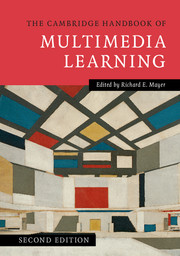Crossref Citations
This Book has been
cited by the following publications. This list is generated based on data provided by Crossref.
Boucheix, Jean-Michel
and
Rouet, Jean-François
2007.
Les animations interactives multimédias sont-elles efficaces pour l’apprentissage ?.
Revue française de pédagogie,
p.
133.
Terrier, Linda
and
Vaillant Sirdey, Christine
2011.
L’acquisition raisonnée d’un laboratoire multimédia de langues : de la théorie à la pratique.
Les Cahiers de l'APLIUT,
Vol. Vol. XXX N° 1,
Issue. ,
p.
42.
Hirsh-Pasek, Kathy
Zosh, Jennifer M.
Golinkoff, Roberta Michnick
Gray, James H.
Robb, Michael B.
and
Kaufman, Jordy
2015.
Putting Education in “Educational” Apps.
Psychological Science in the Public Interest,
Vol. 16,
Issue. 1,
p.
3.
Khim Leow, Choy
Wan Yahaya, Wan Ahmad Jaafar
Mohammad, Mariam
and
Liu, Songhao
2015.
Mobile-assisted second language learning: Speaking a second language with auditory stimuli.
Issues in Language Studies,
Vol. 4,
Issue. 2,
Ayres, Paul
2015.
State‐of‐the‐Art Research into Multimedia Learning: A Commentary on Mayer's Handbook of Multimedia Learning.
Applied Cognitive Psychology,
Vol. 29,
Issue. 4,
p.
631.
RundellSinger, Susan
2015.
Handbook of Science and Technology Convergence.
p.
1.
Yu, P.‐T.
Wang, B.‐Y.
and
Su, M.‐H.
2015.
Lecture capture with real‐time rearrangement of visual elements: impact on student performance.
Journal of Computer Assisted Learning,
Vol. 31,
Issue. 6,
p.
655.
2015.
Learning as a Generative Activity.
p.
1.
Lee, Hyunjeong
and
Mayer, Richard E.
2015.
Visual Aids to Learning in a Second Language: Adding Redundant Video to an Audio Lecture.
Applied Cognitive Psychology,
Vol. 29,
Issue. 3,
p.
445.
Merrienboer, Jeroen J. G.
and
Dolmans, Diana H. J. M.
2015.
Researching Medical Education.
p.
193.
2015.
Learning as a Generative Activity.
p.
124.
Rundell Singer, Susan
2015.
Handbook of Science and Technology Convergence.
p.
1.
Rundell Singer, Susan
2016.
Handbook of Science and Technology Convergence.
p.
1059.
Renkl, Alexander
2016.
Handbuch Bildungsforschung.
p.
1.
Graham, Steve
Fishman, Evan J.
Reid, Robert
and
Hebert, Michael
2016.
Writing Characteristics of Students with Attention Deficit Hyperactive Disorder: A Meta‐Analysis.
Learning Disabilities Research & Practice,
Vol. 31,
Issue. 2,
p.
75.
Fang, N.
and
Guo, Y.
2016.
Interactive computer simulation and animation for improving student learning of particle kinetics.
Journal of Computer Assisted Learning,
Vol. 32,
Issue. 5,
p.
443.
Pirkl, Gerald
Hevesi, Peter
Lukowicz, Paul
Klein, Pascal
Heisel, Carina
Gröber, Sebastian
Kuhn, Jochen
and
Sick, Bernhard
2016.
Any problems? a wearable sensor-based platform for representational learning-analytics..
p.
353.
2016.
e‐Learning and the Science of Instruction.
p.
29.
Irrazabal, Natalia
Saux, Gastón
and
Burin, Debora
2016.
Procedural Multimedia Presentations: The Effects of Working Memory and Task Complexity on Instruction Time and Assembly Accuracy.
Applied Cognitive Psychology,
Vol. 30,
Issue. 6,
p.
1052.
Goldwasser, Molly
Mosley, Pamela L.
and
Canelas, Dorian A.
2016.
Online Course Development and the Effect on the On-Campus Classroom.
Vol. 1217,
Issue. ,
p.
63.





